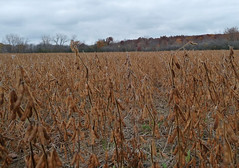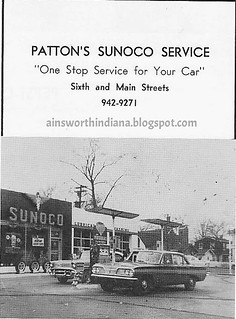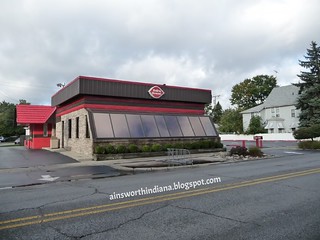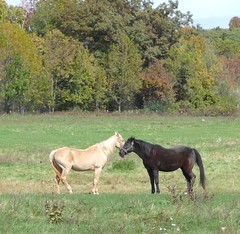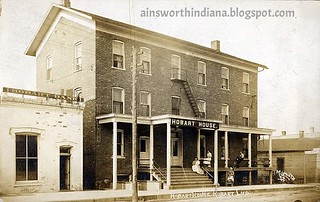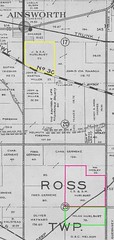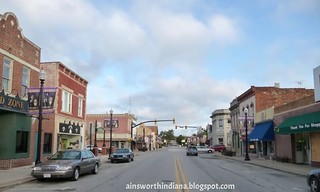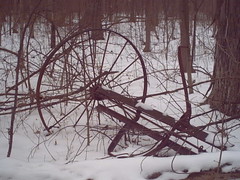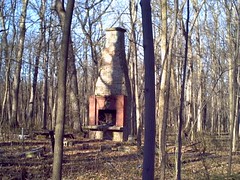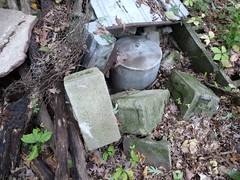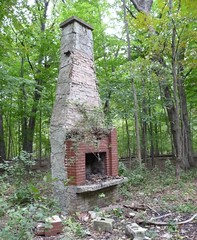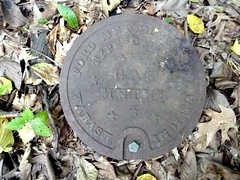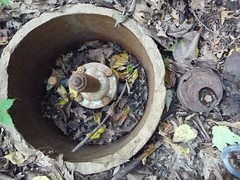We have briefly met William Raschka, the "
merchant of Ainsworth," and his wife Carrie, the daughter of Henry Chester. They were married for almost 65 years before death parted them in 1959.
Thirty years before that, however, they had been parted for nearly a week by a bizarre and rather embarrassing incident. Before we dig up that old scandal, though, let's fill in some of the background.
William and Carrie married in 1894, when he was about 25 years old and she 20. By 1900 they had two young children and lived in Ross Township. To the federal census taker, William modestly described himself as a farm laborer. But he was ambitious and enterprising.
In 1902 he opened his general store in Ainsworth. In 1906 Carrie's stepmother transferred a nice package of land to him, totaling about 110 acres. By the 1910 census, William (now a "retail merchant") and Carrie had three children, and their household included William's brother Frank, working as a salesman in the general store, and two hired girls who probably helped with the house and children, since Carrie gave her occupation as saleslady in the general store.
In 1916 William, Carrie and their children moved to Hobart, at first renting a house, then buying their own in 1917. (Brother Frank Raschka had moved out, married and started a family.)
By 1926, real estate sales were part of William's business enterprises, which still included the general store and the shipping of hay and grain. The partnership of Raschka and Mayne advertised real estate offerings in the local papers and operated out of Gary and Hobart.
The first sign of trouble is the appearance of William's name on the published list of delinquent taxes. In January 1928, he was delinquent by about $815 in taxes on various Porter County parcels. In January 1929, he was behind by $1,020 (about $12,540 in today's dollars).
By early November of 1929, of course, William had plenty of company in his financial woes, but that must have been of little comfort to him. He was increasingly pressed and troubled, and Carrie knew it. On November 1, William went to Chicago to see a "transfer man" by the name of Thornton Haynes in an attempt to get $10,000 — whether as a loan from Haynes or as the repayment of William's loan to him isn't clear. In any event, he didn't get the money. He came home to Carrie deeply worried.
He seemed in better spirits the next morning, Saturday, November 2. He had breakfast and promptly dressed, putting on a black suit, gray overcoat and gray hat. As he went out, he told Carrie to expect him back for lunch.
Lunchtime came — no William. Perhaps Carrie gave it little thought at first, but as the afternoon wore on, as evening approached with no word from her husband, she had time to think of his increasing money troubles and his depressed mood the night before. Dinnertime passed — nothing. Carrie grew uneasy. She explained the situation to relatives, and they started looking for William.
They discovered that he had been seen in Gary around 5 or 6 p.m. Saturday evening, when he brought his car to the Universal garage for some minor repairs. The garage attendants, who knew him well, thought he was oddly preoccupied that day. He told them he'd be back in a few hours to get the car, but he never showed up. Sunday morning Carrie had the car brought back home. The search continued.
Somehow the family found out or concluded that William had gone to Chicago. They checked with a few Chicago contacts, but turned up no further information.
The family decided it was a matter for the police.
On Wednesday the case hit the front page of the Valparaiso
Vidette-Messenger. Police throughout northern Indiana and in Chicago joined in the search for William. Carrie said his financial troubles may have made him "mentally deranged"; perhaps she feared the worst. Again on Thursday, the
Vidette-Messenger's front-page story reported only a continuing mystery. What had become of William?
And then the case dropped out of sight.
Days went by without a word from the newspapers.
Finally, on Tuesday, November 12, the
Vidette-Messenger sheepishly reported (on page two) that William was back home, safe and sound. The story said, "He was found in Kansas City, Mo., where he woke after being apparently under the influence of drugs. Raschka would not comment upon his experience other than to say he was not robbed."
Who found him? How did they know to look in Kansas City? What drugs, and how had he come to take them? The answers to these questions are lost to history. I don't know whether that reflects journalistic laziness or editorial discretion — William was a prominent local businessman, and after all, it's no crime to go to Kansas City. And with the embarrassment of having the police of three counties looking for him, and his financial troubles and mental condition splashed over the front page of the newspaper — William had already suffered for his little adventure.
But oh, how I wish I'd been a fly on the Raschka walls the day William came home!
Their troubles weren't over. Before November was out, a lawsuit alleging fraud in a land transfer was brought against them by Walter and Lottie Neath, friends of at least a decade; in 1932 some of the Raschkas' Porter County assets were auctioned at a sheriff's sale.
After that, however, we hear of no more troubles, only joys. In 1933, William, Carrie and their three daughters visited the World's Fair in Chicago. William concentrated on his real estate business, and the local classified columns of the mid- to late-1940s often featured property he was selling.
In April of 1944, William and Carrie held an open house to celebrate their 50th wedding anniversary, and again in May of 1954 for their 60th anniversary.
William died in 1959 at the age of 90. Three years later, when Carrie was 87, they were reunited.
Sources:
♦ Ancestry.com. 1900 United States Federal Census [database on-line]. Provo, UT, USA: Ancestry.com Operations Inc, 2004. Original data: United States of America, Bureau of the Census. Twelfth Census of the United States, 1900. Washington, D.C.: National Archives and Records Administration, 1900. T623, 1854 rolls.
♦ ———. 1910 United States Federal Census [database on-line]. Provo, UT, USA: Ancestry.com Operations Inc, 2006. Original data: United States of America, Bureau of the Census. Thirteenth Census of the United States, 1910. Washington, D.C.: National Archives and Records Administration, 1910. T624, 1,178 rolls.
♦ Hobart High School Aurora Yearbook (1927).
♦ Inflation Calculator. [Online calculator.] Dollar Times. Retrieved from http://www.dollartimes.com/calculators/inflation.htm.
♦ Lake County Times (Hammond, Ind.). Nov. 21, 1906; May 23, 1919.
♦ Times (Hammond, Ind.). Mar. 13, 1917; Jul. 6, 1926.
♦ Vidette-Messenger (Valparaiso, Ind.). Jan. 27, 1928; Jan. 26, 1929; Nov. 6, 1929; Nov. 7, 1929; Nov. 12, 1929; Nov. 22, 1929; Oct. 26, 1932; Sept. 25, 1933; Apr. 24, 1944; Jul. 17, 1945; Feb. 28, 1946; Mar. 7, 1947; Sept. 1, 1948; May 10, 1949; Apr. 27, 1954; Feb. 13, 1959; Dec. 31, 1962.


